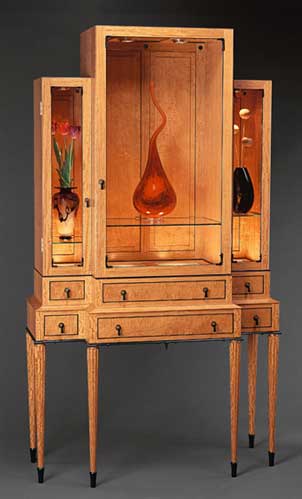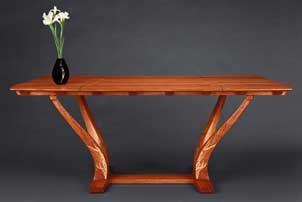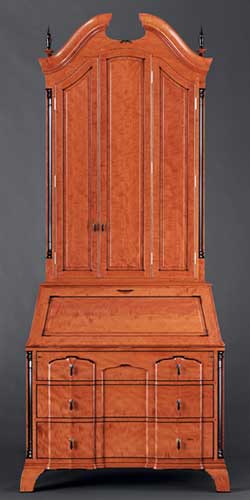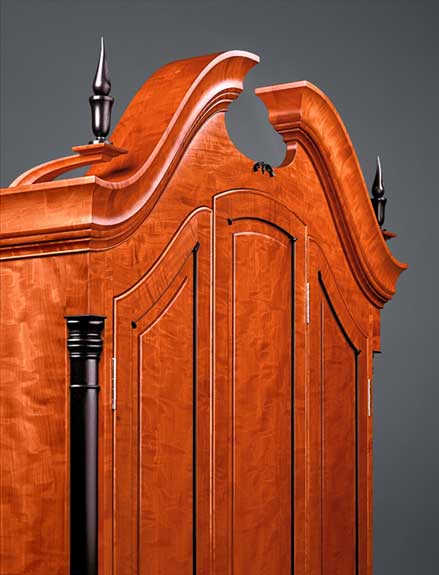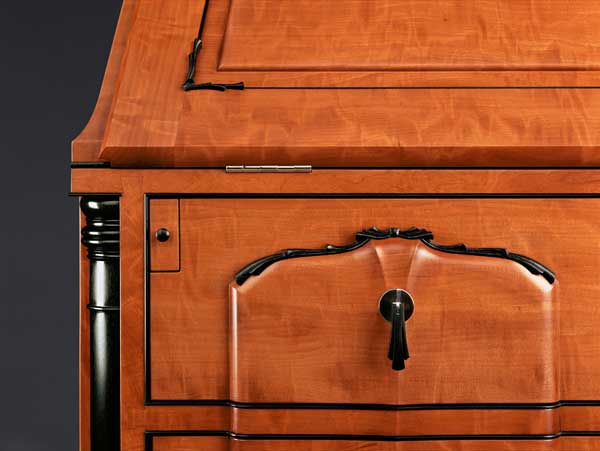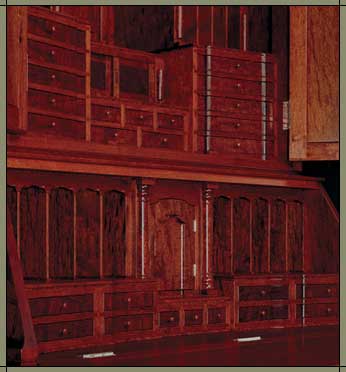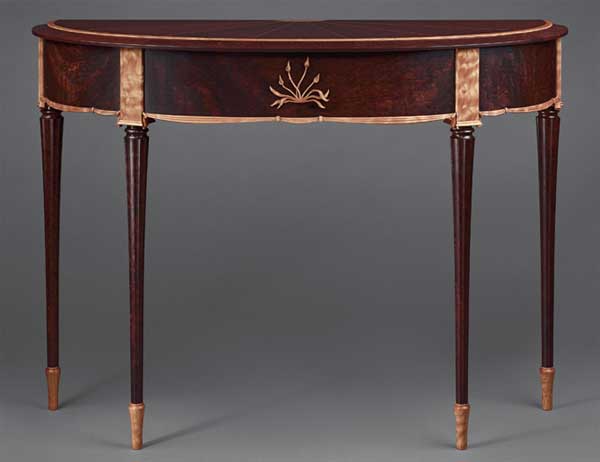
For the past quarter century, Ken Richards has been designing and making world-class furniture in the Pacific Northwest. While there are some clear nods to modernity in his work, much of it takes its influence from the classic pieces of the past. In a sense, he does too, favoring paper drafting over computers and leaning heavily on hand tools for many operations.
Combining elegant design with flawless execution, his pieces are more than deserving of the carriage trade prices he charges. Even lofty achievements, though, have humble beginnings, and Ken’s path is no exception. “Growing up,” Ken recounted, “my father had a kit-built table saw with wooden wings and stand. I think it was an eight-inch Craftsmen. It was laughable, but it was a start, and it was the first power tool I can remember using.
“In my teens, I started doing wood projects. My first was a fish tank. Normally, you’d think that would be all out of glass, but mine had a wooden bottom, back and top, covered in fiberglass, with a glass front. It was about six feet long and held 80 gallons. I installed it in my parents’ living room.
“During my youth, my father worked for Boeing and belonged to a club that built and flew model airplanes. They’d have competitions for hand-launched gliders, and I have vivid memories of both the building process and the meets. Initially I built them with my father, but was soon doing it on my own. For me, building something with my hands was a very satisfying process. In high school, I took a lot of drafting classes and, in the woodshop, built a model of a house I had drawn and designed.” That was fairly prophetic; years later he would design and build not a model, but the actual house he now occupies.
“After high school, I went to work at Boeing as a draftsman. Unfortunately, I enjoyed paper drafting far more than computer, and I could see the handwriting on the wall. When I was 20, I managed to buy an entire woodworking shop from someone moving out of the area.
“In my mid-20s, I bought five acres in Maple Valley, Washington, and put down roots. I’m still here. There was a barn on the property which became my woodshop. It was not too efficient because it was on three levels. As luck would have it, the shop burned down in 1991, which gave me the opportunity and impetus to build the shop I now work in. By that point, I was committed to woodworking as a living and was doing it as a full-time activity. Being in a shop designed specifically to be a woodshop is a real advantage. My current shop is very efficient, and boasts a lot of lumber storage.
“Some time in the late 1980s, I saw a project by a local woodworker that made it into a major woodworking magazine. It was a cylinder desk made of ebony, Brazilian rosewood, mother-of-pearl and other exotic materials. I didn’t think people were still making furniture out of things like that, and it stuck in my mind that was something I would love to do. In the late ’90s, I got my chance.
“I was working for someone who had a real appreciation both for exotic woods and my work, and I proposed that we sit down together and talk about some of my dream projects. Two that came to fruition were a pear wood secretary and a demilune table of ebony, accented in amboyna burl. Eventually, I did two other demilune tables in imbuya and one in padauk. Although I don’t go back and repeat designs, I do like to build in sets. Often I’ll use different woods, a factor that can bring a dramatic difference to pieces that share the same design.
“The other project from that discussion, the pear secretary, was inspired by another article, written in the 1980s, about a Goddard secretary that had been sold for 12 million dollars. Someone commissioned a man to do a copy of it, and he wrote a comprehensive article about the process. That knocked me over. Secretaries seem to me to be the ultimate furniture form, sort of like a giant jewelry box. I decided to do my own contemporary interpretation of the Goddard piece.
“My pear secretary is nine feet tall, has close to 30 drawers and 20 pigeonholes, and there are about 10 secret compartments hidden within. It is one of two I made together, the other in mahogany. Making the secret compartments was certainly one of the more fun aspects of it, along with detailing the interior layout. It took about 6,000 hours to build the secretary and its mahogany mate. I did it over a three-year period while I was also building my new home.
“As you can see, my furniture designs tend to be fairly formal, and are all made from solid wood with no veneers. I frequently work with exotic woods because I think they are beautiful. Of course, when I first started working with woods like cherry and walnut, I thought that was wonderful, too. After all, it was a big step up from working with pallet wood.
“I recall at one point getting a great deal on a stack of koa, and that was another eye-opener. That led me into more exotic woods, and I developed a relationship with a wood dealer who has been both a supplier and educator to me about wood species. Over the years, my base of exotics has expanded, and I’ve developed a collection of several hundred exotic samples from all over the world. They intrigue me, and in some cases are very handy for showing to customers.”
Besides exotic woods, Ken also favors hand tools, and obviously gets great joy from jobs that demand such work. “At present,” he told me, “I’m working on a very sculptural project. Its purpose in life is to display works of art. It has 11 platforms supported by a sinewy structure, with eight or 10 vertical elements that are interconnected by horizontal elements. I started calling it a sculpture tree, but at this point I think it has evolved into more of a garden.
“The piece will probably take about 10 months to do, and relies on a lot of hand tool work. As I have developed skills with hand tools, I have found that the time spent working with them, quiet time, is about as good as it gets. I feel both motivated and lucky on a daily basis. Woodworking is a wonderful way to spend your days,” he concluded, “and I feel like this is what I am supposed to be doing.”
